-
Paper Information
- Paper Submission
-
Journal Information
- About This Journal
- Editorial Board
- Current Issue
- Archive
- Author Guidelines
- Contact Us
Architecture Research
p-ISSN: 2168-507X e-ISSN: 2168-5088
2020; 10(2): 54-59
doi:10.5923/j.arch.20201002.02

Investigation of the Relationship Between the Concept of Belonging and Sustainable Urban Conservation Process: The Case of İzmir- Sığacık Inter Castle Settlement
Nihal Arda Akyıldız , Tuba Nur Olğun
Department of Architecture, Fırat University, Elazığ, Turkey
Correspondence to: Tuba Nur Olğun , Department of Architecture, Fırat University, Elazığ, Turkey.
| Email: |  |
Copyright © 2020 The Author(s). Published by Scientific & Academic Publishing.
This work is licensed under the Creative Commons Attribution International License (CC BY).
http://creativecommons.org/licenses/by/4.0/

People's lives and daily behavior patterns; comes to life in the social and physical environment to which they belong. The individual interacts with the space as a 'subject' in the first order and creates the process of transforming it into 'place'. The bond / emotion that the individual establishes with the space provides the richness and interaction of his daily and social life. Space-subject relationship is also closely related to the individual's sense of belonging. Being a part of a place can be considered as an important parameter of space choice for the user. In this context, the protection and sustainability of the places are successful in direct proportion with the sense of belonging to the user. Considering the traditional urban areas reevaluated by conservation studies today, the continuity of the use of individuals living and working in these areas is of great importance in the context of the sustainability of these areas. The users' feelings of these areas ensure that the physical interventions are positive in the context of conservation and sustainability. Conservation of regions where traditional texture is present in growing cities; While maintaining the existence of urban spaces, on the other hand, it maintains the continuity of the social and spatial life with which the individual is associated with the bond. In this context, accepting the sense of individual and social belonging as one of the basic planning parameters in the urban conservation process; is an important issue for both social and spatial sustainability. The aim of the study is to examine the traces of the concept of belonging through the conservation and sustainability of traditional settlements in urban areas and open them for discussion. In this context, the urban protection, sustainability and belonging phenomena are examined, and İzmir-Sığacık castle area, which is selected as an example area and where these phenomena stand out, is discussed. Sığacık Castle settlement, which allows the results of the sense of belonging with its permanent users and touristic aspects to be evaluated from different perspectives, is a very rich example in the context of the relationship between belonging-urban conservation and sustainability. As a working method, the related literature has been examined and on-site observations are detailed. From this point of view, the study is thought to be useful in emphasizing the relationship between urban conservation and sustainability not only with concrete-physical concepts but also with abstractness, which is an abstract concept.
Keywords: Urban Conservation, Sustainability, Belonging, Sığacık Inter Castle Settlement
Cite this paper: Nihal Arda Akyıldız , Tuba Nur Olğun , Investigation of the Relationship Between the Concept of Belonging and Sustainable Urban Conservation Process: The Case of İzmir- Sığacık Inter Castle Settlement, Architecture Research, Vol. 10 No. 2, 2020, pp. 54-59. doi: 10.5923/j.arch.20201002.02.
Article Outline
1. Introduction
- The subject of space, which is an important study issue in almost every area in different periods, is a valuable parameter to understand and perceive the society in which it is located. It is an obligatory context to address the issue of space as an important plane in every study whose subject is human [1]. Urban space, which is a natural plane for cultural and intellectual images as well as social relations networks; has also been an essential element of the social processes experienced throughout its existence. For this reason, world and human history are generally handled in accordance with urban life processes. In addition, the relationship between human and environment is explained through these spatial experiences and transferred to historiography. Urban spaces, which are the stage of social life, are places where perceptions and experiences turn into personality, consciousness and memory in daily life, and they are also shaped by different meanings and identities that individuals place on space. The main subject and basic element of architecture is space; which has been created and embodied with different physical limits and different variables in perception levels throughout history [2]. Throughout history, social events and space experiences have created different forms of memory for the subject. Maurice Halbwachs, in his book 'On Collective Memory', commented about memory; that the subject is in direct contact with his past and is related to his existence; he also stated that the collective background of individuals as a subject continues to exist socially [3]. In this context, the user of the space, as a subject, can feel himself 'belonging' to the places in his memory and in his past experiences. This belonging affects the point of view and usage patterns deeply.Today, most of the urban areas have lost their traditional qualities; such that we see the influence of the sense of belonging is felt at a limited level and is replaced by modernized spaces. In this sense, researching the effects of belonging phenomenon in urban areas, which have not lost their traditional identity and sustained with various conservation activities, is of great importance in terms of contributing to the conservation and sustainability of similar places. The purpose of this study is to reveal the effects of the sense of belonging, among other parameters, in the conservation and sustainability of urban areas. In this context, the concepts of urban conservation and sustainability are examined and the İzmir-Sığacık Castle Area, which includes multi-faceted features within the scope of the subject, is discussed. The data provided by the Sığacık settlement, which has reached today with various conservation activities and allows the sense of belonging with its touristic users as well as various aspects, constitutes the main scope of the study. Urban conservation and sustainability of the evaluations made as a result of the study are not only with concrete applications; meanwhile it is also aimed to raise awareness that it should be provided through abstract concepts, especially belonging.
2. Urban Conservation and Sustainability
- Studies for the protection of historical and cultural assets in our country started quite late compared to the developments in the world. In this context, it was too late in the process of conserving historical and traditional buildings; therefore, many historical buildings have been lost. The development of settlement scale conservation works as well as single structure conservation studies at a very late date caused many urban and rural settlements to be destroyed or disappeared.Cities are dynamic assets that are in constant change and transformation [4]. In this context, the integration of cities and their adaptation to the modern age are holistic visions and operations aimed at developing physical, environmental, economic and social conditions for the solution of the problems of a changing settlement [5]. These integrated studies also include the aim of integrating the old and new settlements of the city in the most appropriate way. Urban conservation is a versatile phenomenon that includes data on a legal, physical, functional, socio-economic and planning-implementation scale [6]. The handling of all these data together and correctly is of great importance in the context of transferring the traditional and modern areas of cities to the future.The concept of sustainability has been on the agenda since the 1970s; however, it is an approach that increases its effect and validity day by day. The use of the concept as we know it today is demonstrated by the Bruntland Report published by the United Nations in 1987. In the report, the concept of sustainability is defined as “meeting today's needs without compromising the ability of future generations to meet their own needs” [7]. In this context, sustainability is a frequently discussed issue in the field of urban conservation as in many other areas [8]. Sustainability, which can be expressed as the starting point, to prevent environmental problems occurring in parallel with economic and technological developments and to protect the ecosystem, is directly related to urban conservation efforts in this respect [9].When the systematic of sustainable architecture is examined in terms of design components; conservation of energy and natural resources, in addition to the design of the building life cycle, important sustainable architectural components such as biological structure design stand out. The concept is nourished by the system of thought that meets the expectations of 'human existence in time', 'coming in time' and 'existing in both today and tomorrow'. The interpretation of the concept with another approach; - Resource management; ensures that the natural resources that bring the existence of the structure are recycled together with the effective use and the reuse of the natural resources,- Building life cycle design; it covers the effects of all processes, from the design process of the building to the demolition, on the natural environment,- It includes design for man and protecting and strengthening the natural environment relations with man [10].Placing only the human element in the center of the urban conservation and sustainability relationship is not enough. A clear farsightedness and identity are important for the city as it constitutes the starting point of the sustainability process [11]. One of the most important elements that make up the identity in question is the structures and the cultural elements that shape these structures. In this sense, it is possible to state that urban conservation and sustainability are two phenomena that are linked in many different ways.
3. The Concept of Belonging and the Importance of Urban Belonging for the Individual
- There are many definitions of the concept of belonging; however, it does not have a widely accepted general expression, such as the concepts of globalization, modernism and post-modernism. It is known that on Maslow's 'pyramid of needs', which is one of the most important representatives of the discipline of psychology, belonging comes immediately after physiological needs and security needs [12]. Turkish Language Association defines the concept of belonging as 'interest and relevance'. The concept means to be part of 'something' as a natural need, to be included [13]. It is a phenomenon shaped by the interaction of concepts, experiences and actions with emotions and beliefs [14]. This important phenomenon is defined as a 'bond / communication' in terms of the relationship between the individual and 'place / space' [15]. Individuals give their identity to these defined areas by shaping the spaces according to their habits. Space gives identity with the potential of sense of belonging created in the individual [16]. The changes and demands of the individual in the spatial field in line with his habits and demands reinforce both his existence and identity [17]. The sense of belonging, the sense of trust, memory and addiction in the individual, and the positive perception of space; defines everything with these basic references. In addition to shaping the living standards, space has an important social directing power with the potential to regulate social behaviors [18]. In this context, the behavior of the individual will be different in places where there is a sense of belonging and not, and this difference will direct the society in which the individual is located accordingly. From this point of view, it is possible to state that the effect of feeling belonging to a place is quite large both individually and socially.The sense of belonging may strengthen and weaken depending on the results of social and cultural interactions [19]. In this context, by changing cities, the sense of belonging is deeply affected and sometimes strengthened; whereas sometimes it appears to be weakened in some areas. Thus, the impact of the concept of belonging is undeniable in the context of the sustainability of cities, which are protected both physically, socially and culturally.
4. Evaluation of the Sığacık Castle Area in the Context of Sustainable Urban Conservation-Urban Belonging Relationship
- Sığacık, which is a neighborhood of Seferihisar district in the southwest of İzmir and located approximately 5 kilometers from the district center, is an important port city where various zoning activities have been carried out since the 7th century BC. There are rooted ancient cities such as Klazomenai, Lebedos, Myonnesos and Erythrai around it [20].Sığacık, which was called Sığala or Sığla in the Ottoman period, became an important center with many features with its castle and harbor built in the 16th Century [20]. Sığacık, which remained as a sub-district until the end of the Ottoman period, is mentioned as a natural port of Seferihisar [21,22]. The castle settlement, consisting of an inner and outer castle, still maintains its borders to a great extent today. Although Sığacık Castle boundaries remains its existence today, life in the castle has changed greatly in the process. However, it is possible to state that a new settlement area has been formed around the castle.Today, Sığacık Castle and the area inside the castle is an important conservation area with traditional structure and culture (Figure 1, 2). In this field, which has been brought to the present day with various applications, besides the permanent users of the region; there are also visitors to the venues that have been re-functioned and converted into accommodation structures, as well as those who visit the bazaar that is set up every week (Figures 3, 4).
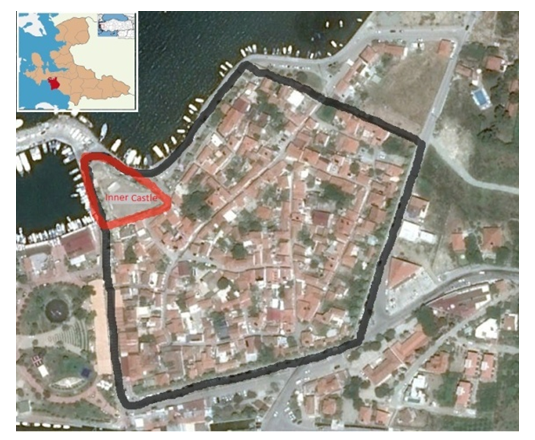 | Figure 1. Location of Sığacık Castle [23,24] |
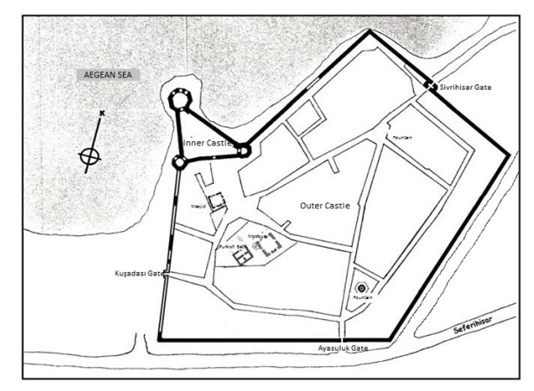 | Figure 2. Sığacık castle location map [20] |
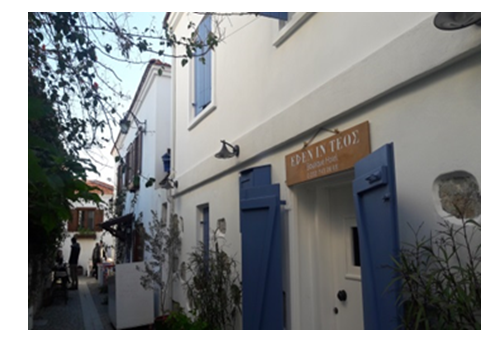 | Figure 3. A traditional building that functions as a boutique hotel within the castle |
 | Figure 4. The part of the bazaar established in the castle, located in the inner castle |
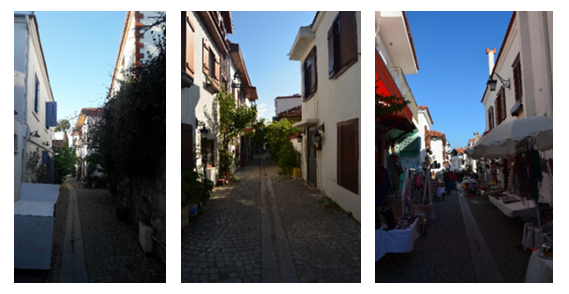 | Figure 5. Streets preserving the traditional texture by being conserved in Sığacık castle |
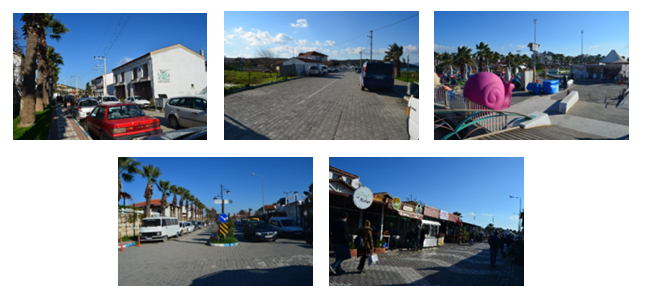 | Figure 6. Streets preserving the traditional texture by being conserved in Sığacık castle |
 | Figure 7. A pension with various traditional symbols at its entrance |
 | Figure 8. A market where local products are sold and can be considered as a symbol of belonging |
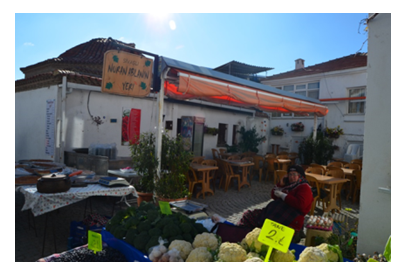 | Figure 9. A user who comes from a different culture but today 'belongs' to the castle of Sığacık |
5. Conclusions
- Sustainability is a concept that is closely related to almost every discipline today. In this context, when the discipline of conservation is analyzed, it is seen that it basically coincides with the concept of sustainability in many subjects such as ecological design, observation of future generations, and proper use of resources. This overlap also appears at the level of urban conservation. With the ecological nature of traditional building production culture and natural resources; the use of materials that do not harm the environment, and the fact that these structures and the living culture owned by the environments in which they are located are also oriented towards production and natural life, make traditional urban textures sustainable areas. In this sense, the conservation of these textures and their transfer to future generations are also of great importance in the context of sustainability.The parameters that make urban conservation sustainable are not only concrete and physical; they also include an abstract set of concepts. At the beginning of these abstract concepts is the phenomenon of belonging. Protection and sustainability of the environment in which the user feels belonging to a place; will give results in a different way than the environment in which users do not think that they belong to that place. In this context, belonging is a concept that has supportive and positive effects in the context of urban conservation and sustainability. Spatial and social belonging planes, which are one of the parameters to be taken into consideration in urban conservation, are phenomena that affect not only a certain period but also intergenerational periods and add an important identity and originality to the urban area. In urban conservation, it is an important urban heritage to be able to strengthen the memory of the region without losing it. Being an important reference of social relations, belonging and the potential to embrace and give identity to the spatial plane are a spontaneous feeling of individual and social life. This feeling is one of the main reasons for the sense of attachment or abandonment to the urban area. The İzmir-Sığacık Castle Interior settlement, where the concept of belonging stands out and can be preserved to a great extent, is observed; and despite the new construction and modern arrangements around it; the settlement is a highly qualified residential area that makes both permanent and temporary users feel a sense of belonging. Since users' sense of belonging in this settlement contributes to the protection and sustainability of the area; the mutually beneficial relationship between the concepts of belonging and urban conservation is also displayed on the settlement studied. In this context, in Sığacık settlement;- Although the buildings were restored and re-functionalized, it was seen that the symbols of the region were tried to be protected by the user.- It is seen that there are many products reflecting the local culture in the market established every week in the settlement and the existing traditional building stock supports the display and sale of these products.- Due to the harmony of texture in the spatial weave even people from different cultures and regions can be observed to spend a pleasant time in the settlement area, thereby supporting daily living routines and a sense of social belonging.- It has been observed that the residents who live in this residential area strive to preserve their existing cultural habits with a sense of belonging and even contribute to spatial and social sustainability with a sense of cultural heritage by transferring it to other generations.The transfer of all spatial planes such as streets, houses, public spaces and open market areas to the present day, and the fact that the sense of belonging of daily life habits are still felt and kept alive at every point of the settlement reveals how successfully the sustainable urban protection process has been achieved. This successful conservation process has two major branches. One is the architects and city planners who successfully carry out the protection process of sustainable spatial planning criteria, and the other is that the local people, who are the real owners of the settlement, embrace the socio-cultural heritage and habits with their sense of belonging and sensitivity to the region. With this two-way effort, sustainable social and spatial life in cities can be created and conserved in the region's cultural heritage. As a result, it is thought that the study will make a positive contribution in the context of emphasizing the relationship between the concepts of urban conservation and sustainability and belonging in the Sığacık Castle settlement.
 Abstract
Abstract Reference
Reference Full-Text PDF
Full-Text PDF Full-text HTML
Full-text HTML